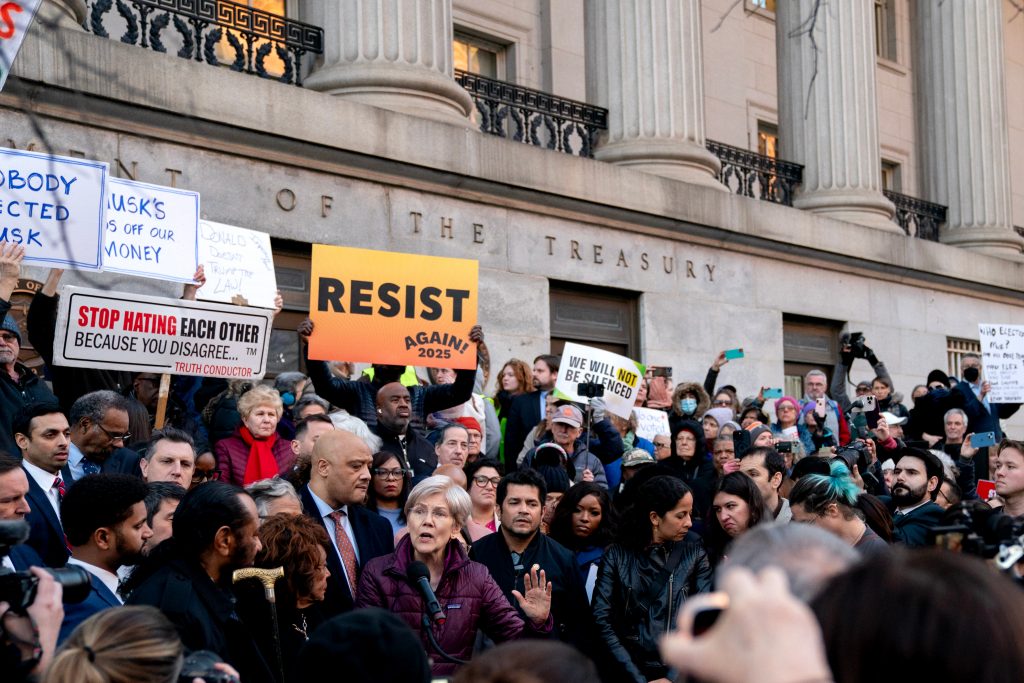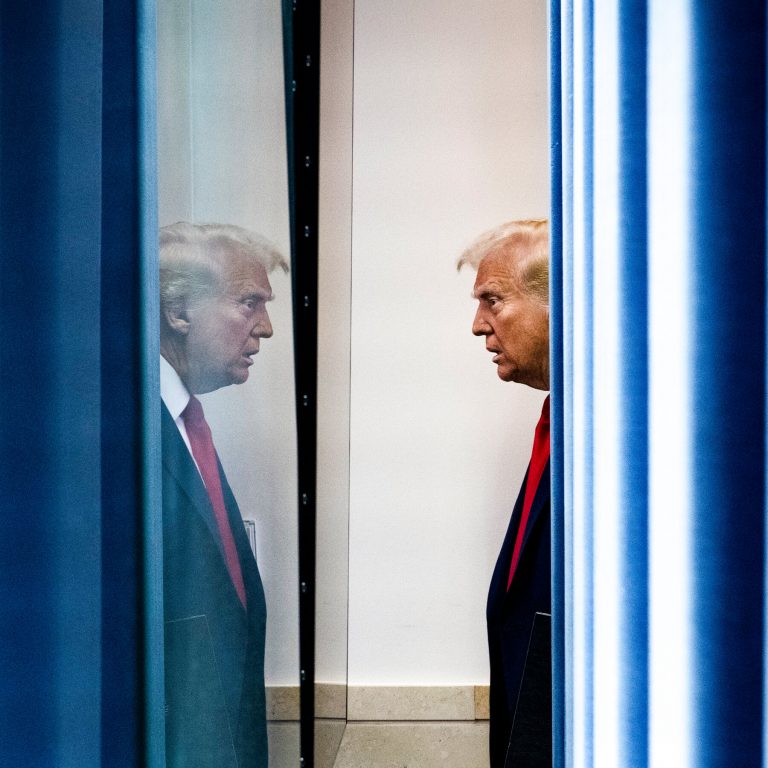

If there is ever going to be a Resistance movement 2.0, it might have gotten a much-needed jolt of energy this week.
Gathered on the eastern steps of the US Treasury Department’s DC headquarters Tuesday evening, some two dozen Democratic members of Congress rallied a few hundred protesters against Elon Musk. Specifically, they were protesting his disassembly of the federal workforce and rapid takeover of access to the government’s payment systems, at President Donald Trump’s behest. “Nobody elected Elon!” the posters they brought read.
“The crisis is here,” declared US Rep. Jasmine Crockett of Texas. “I know some of y’all have been frustrated and you’ve been saying, ‘Where are the Democrats, where are our leaders?’ Well I’m here to tell you that we ain’t never left y’all. We are here. We are also going to make sure that they uphold the law. We are not going to sit around while you go ahead and desecrate our Constitution.”
While the protesters remained outside, the group of senators and representatives tried to enter the building. They were denied.
The stunt wasn’t the first time this week that Democrats have tried pick fights with Trump and Musk — which is quite different from how they’ve been behaving.
For at least the last three weeks, those embarrassing questions that Crockett called out have dogged the Democratic Party. Where has the opposition’s response to Donald Trump been?
As he took office, Democrats seemed to flounder. When he signed a flurry of controversial executive orders — directly challenging Congress, the Constitution, and the courts — the Democrats held press conferences, went on cable news, or tried to cooperate and find common ground. But Trump was dominating the media coverage and public’s attention. As he tried to consolidate power, ordered freezes in government spending, and delegated power to Musk and his so-called Department of Government Efficiency, routine Cabinet hearings and confirmations continued.
If Democrats felt a sense of urgency, it wasn’t coming across to the general public. And the absence of any large-scale, well-organized anti-Trump protests only added to the uncertainty that a new resistance would ever show up. Those trying to organize the Democrats’ activist base wondered if any leaders would decide to make a stand.
That first weeks of Trump’s second presidency have been a far cry from 2017. Buoyed by mass outrage and massive public demonstrations, like the Women’s March, Democrats felt a stronger imperative to fight back. It was around this time eight years ago that large-scale protests developed in DC and around the country in response to Trump’s first “Muslim ban” attempt. And that energy sustained itself til at least the 2018 midterms.
Yet since November, nothing close to that movement has reemerged. The avalanche of Trump moves has made it difficult for anything else to break through. And the party hasn’t been able to agree on a central point, or message.
But that might slowly be changing. The ongoing fight this month over the future of US Agency for International Development (USAID), the independent federal agency in charge of international development and relief, and the uproar over who actually controls the Treasury Department’s flow of money, might have offered the first glimpse of a new form of Trump resistance.
As Musk and other Trump loyalists continue reshaping the executive branch, dismantling agencies and taking over key offices, Democrats — both elected and the grassroots — seem to finally be jumping into action.
In Congress, they’re embracing political and procedural theater. Outside of government, the party has new leadership, and, potentially, a new strategy. And progressive and activist groups are mobilizing for protests and demonstrations in the capital this week and beyond with a specific target: Musk, and Trump’s billionaire boosters.
That an internal dismembering of the federal bureaucracy might end up being the beginnings of a new movement is unexpected — but the Democrats starting any fight has been the basic ask of liberal activists.
“If you don’t create friction, then the American people don’t understand exactly how bad and how dangerous this is,” Leah Greenberg, the co-founder of the progressive organizing group Indivisible, told me. “A lot of people don’t have personal, deeply held beliefs about the separation of powers or constitutional division of authority between Congress and president. The way they figure out that something is a crisis is that people tell them it is a crisis.
“From our perspective, Democratic leadership was not fulfilling that really crucial communications role that was necessary and/or were signaling with a variety of actions that it was business as usual. [On Monday] I think we’ve seen something shift.”
It might have taken a minute. But is this the anti-Trump resistance finally coming together?
What Resistance 2.0 looks like so far
The first signs of these new resistance efforts came in the response to what’s been happening at an organization that few Americans really understand: USAID. Musk and his deputies made USAID the target of cuts and restructurings last week, and it’s now basically been disintegrated.
Employees for the independent agency were told Sunday night not to show up to work at the DC headquarters on Monday, sparking fears that the agency would be completely shut down. That news came as it became clear that DOGE was being given access to the federal government’s system for issuing payments and reviewing the flow of federal funding, giving a handful of Musk staffers significantly more power.
The two major challenges to resistance now, beyond Democrats’ loss of the popular vote and Trump’s popularity, are institutional and material.
That presented elected Democrats, organizers, and grassroots activists a new starting point for rallying media coverage, public scrutiny, and good will for opposition to Trump.
On Monday, about a dozen Democratic lawmakers, organized by Rep. Don Beyer of Virginia and Sen. Chris Van Hollen of Maryland, descended on the USAID headquarters in downtown DC to make that point. They joined a small group of protesters who had assembled earlier in the morning, holding an impromptu press conference-turned-rally to call out an “illegal” power grab.”
They embraced high-stakes speech and they laid out the stakes clearly: Musk’s takeover of the federal workforce and the federal payment system was a “constitutional crisis,” Connecticut Sen. Chris Murphy said. Musk and Trump were trying to “take away the constitutional power of Congress, [who] have the power of the purse, and decide where money is allocated,” Rep. Ilhan Omar of Minnesota added.
They then tried to enter the federal agency, making sure cameras captured them being denied access, just as New Jersey Sen. Andy Kim had done a few hours earlier.
The morning demonstrations were acts of political theater, of course — but they’re the kind of bold and spontaneous action that many liberals have been asking party leaders to embrace as the Trump presidency continues purging the federal government. Those continued on Tuesday, with the evening protest at the Treasury Department organized by progressive groups MoveOn and Indivisible, and the attempts by House Oversight Committee Democrats and Senate Democrats like Elizabeth Warren and Minority Leader Chuck Schumer to enter the Treasury building.
The two major challenges to resistance now, beyond Democrats’ loss of the popular vote and Trump’s popularity, are institutional and material.
Trump’s party controls most of the levers of power in DC, and Trump has also managed to overwhelm everyone — the public, the press, the Democratic Party — with sheer volume of his actions. He’s made blatantly unconstitutional moves, like trying to end birthright citizenship, and undertaken legally dubious efforts to remake the federal government and workforce. He has also has started flashy and controversial fights over the border, deportations, tariffs, and membership in international organizations. There’s just been so much for Democrats to respond to, with such limited tools, that it’s been difficult to rally opposition to one thing in particular.
“The shock and awe is designed to demobilize,” Greenberg told me. “It’s designed to move the goals, move really, really fast before people can contend with everything that’s happening. And for us the way that you cope with that is by making clear this is all part of one shared story. All of the things that they are doing are part of an overarching set of chaos, cruelty, corruption, and unconstitutionality — that they’re trying to break the federal government so that they can take the money from the programs and from your tax dollars and hand it back to the billionaires who back Trump.”
Which makes the USAID and Treasury responses even more interesting. They’re happening as the Democratic Party apparatus shows signs of snapping into focus and laying out more clearly how they’ll use their limited institutional powers to hold up Trump’s agenda and check his actions.
Sens. Brian Schatz of Hawaii and Van Hollen of Maryland said they’d place “blanket holds” on State Department nominations in the Senate to slow down the confirmation process until USAID is back to normal and DOGE efforts back off. Delaware Sen. Lisa Blunt Rochester said she’ll oppose every Trump Cabinet nominee from now on. Van Hollen also told the Wall Street Journal that he was working with a legal nonprofit to prepare a federal lawsuit to block the USAID closure. And other targeted legal challenges to specific executive orders and federal workforce purges continue.
In the House, Minority Leader Hakeem Jeffries issued a new roadmap to House Democrats outlining their priorities for oversight and resistance: protecting Medicare, fighting tax cuts for billionaires, pushing for oversight of Trump and Musk’s federal overhauls, and preparing a better digital and traditional media communications strategy to take all of this directly to their constituents. Other Democrats are offering even more specific options for the party to flood the zone in response to Trump’s attempts to work around Congress on tariffs and federal spending.
The bottom line: Democrats in government seem to be learning that they need to get out in front of the public and say something — anything — to garner eyeballs, attention, and good will from a public that is pretty pissed off at them right now.
And, finally, there’s also some mobilization on the streets.
An array of Musk-related protests are already planned for the rest of the week. Demonstrations are planned all week in front of the Office of Personnel Management, while more demonstrations are likely at the USAID headquarters. On Wednesday, retired and former USAID and State Department staffers protested outside the Capitol. And unionized federal workers will be rallying next week on Capitol Hill.
Whether any of this works is still unknown — though some polling over the last week suggests that the American public is quickly souring on Musk’s and DOGE, as Trump’s approval rating begins to take a hit.
After a few months of flailing, these Democratic actions — and the changing impressions of Trump and Musk — are at least a sign of life that a functioning opposition can still emerge.
Still, even the rally at Treasury offered a harsh reminder that Democrats have a lot more to do. As Rep. Maxwell Alejandro Frost of Florida rallied his colleagues for one final chant for social media followers, they seemed confused. “What do we need?” Frost called out. The response was a garbled mess.




